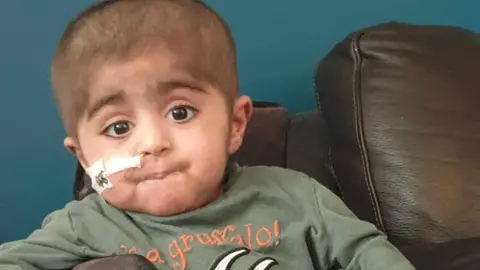A young boy named Eisa from Reading, who has been living with an ultra-rare immune deficiency known as leukocyte adhesion deficiency 1 (LAD-1), has successfully begun a new chapter in his life following participation in a landmark gene therapy trial. The condition, which hinders the immune system’s ability to fight infections, previously left Eisa facing what seemed like a “death sentence.” However, thanks to the innovative treatment, he is now embracing normal childhood experiences, such as playing football and attending school—activities his family once thought were unattainable for him.
Eisa, now four years old, was born at the onset of the COVID-19 pandemic, and his parents quickly recognized that something was amiss. Initially plagued by infections, the family sought help from three different hospitals before finally being referred to Great Ormond Street Hospital (GOSH). There, medical experts assessed Eisa’s condition and determined that a bone marrow transplant was not feasible due to the absence of a suitable donor match. Instead, they recommended the experimental gene therapy, leading his father, Safdar, to promptly agree, saying, “if that’s the only option they have, we have to do it.”
The gene therapy Eisa received operates by modifying the patient’s own immune cells. This enhances their capacity to produce a critical protein necessary for robust immune responses. After undergoing treatment in January 2021 at just ten months old, Eisa’s life became vastly improved; he was able to combat infections independently, effectively securing a future previously deemed improbable due to his condition. “Great Ormond Street saved his life,” his father asserted, acknowledging the invaluable support his son received and expressing gratitude for the medical advancements at the hospital.
Professor Claire Booth, a consultant pediatric immunologist at GOSH, explained that for patients with LAD-1, anything less than 2% expression of the requisite protein amounts to a dire prognosis, often likened to a death sentence without intervention. The breakthrough therapy that Eisa underwent not only transformed his immune system but also demonstrates the potential of gene therapy in treating other serious conditions, including various cancers and muscular dystrophies.
Eisa was treated in an environment rife with concern, as he was caught in a “catch-22” situation. Due to LAD-1, his capacities for healing wounds were impeded, which posed a significant risk for any surgical procedures. Thankfully, following successful gene therapy, Eisa’s health dramatically stabilized. His father shared his astonishment at Eisa’s progress, stating, “How he is now is better than I could have ever thought he would be— I never thought he would be able to walk. The next thing for us will be talking.”
While Eisa now leads a more typical life filled with play and exploration, the journey to this point was fraught with challenges, both medical and emotional. The encouragement and support from healthcare professionals at GOSH proved instrumental in his recovery. In a touching statement, Safdar credited the medical team’s dedication and expertise, underscoring the impact of having access to groundbreaking medical interventions.
As Eisa continues to thrive, the family looks forward to a bright future filled with possibilities—something that just a few years ago felt like an unattainable dream. This story of triumph not only illustrates the power of innovative medicine but also highlights the importance of family, community, and resilience in the face of adversity. It serves as a reminder that advancements in healthcare can bring about remarkable transformations in individuals’ lives, and sparks hope for those facing similar challenges.



